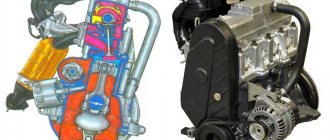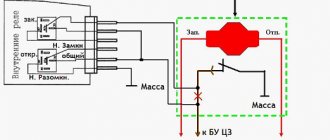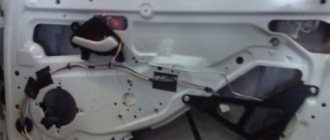The Lada Granta is a budget front-wheel drive car that was developed on the basis of the Lada Kalina. Sales of the car began at the end of December 2011. Currently, 5 types of engines are installed on Lada Granta/Kalina 2:
- VAZ-11183-50 (82 hp)
- VAZ-11186 (87 hp)
- VAZ-21126 (98 hp)
- VAZ-21127 (106 hp)
- VAZ 21126-77 (120 hp)
Despite this diversity, the volume of all engines is the same and is 1.6 liters.
About modern VAZ engines
The manufacturer offers a choice of two 8 valve engines :
- VAZ-11183-50 (82 hp) is a modified VAZ-2111 engine, as a result of which environmental performance has increased, the engine has become more reliable and less capricious. It also has the advantage of elasticity and traction. Disadvantages include periodic valve adjustments and noisy engine operation. If the timing belt breaks, the valve does not bend.
- VAZ-11186 (87 hp) is a modified VAZ-21114 engine, as a result of which it was possible to reduce noise and gasoline consumption. Environmental friendliness has improved and power has increased noticeably. Disadvantages: compared to the VAZ-11183, this engine has a shorter service life. When the timing belt breaks, the valves bend.
16 valve engines :
- VAZ-21126 (98 hp) is a continuation of the VAZ-21124 engine and is currently one of the most advanced domestic engines. Disadvantage: valve bends when the timing belt breaks.
- VAZ-21127 (106 hp) is a modified VAZ-21126 engine. In comparison, the engine has become more torquey at the bottom, the changes are minor, but noticeable. The disadvantages include bending of the valves when the timing belt breaks.
J20A engine tuning
Atmo
Let's consider the potential of the 21116 8V engine without replacing the cylinder head with a 16 valve (The 126 16V engine and its modifications are mentioned in a separate article). The first stage, already familiar to us from tuning the 21114 engine, is replacing the camshaft with a Nuzhdin 10.93, installing a split gear, and adjusting the phases. We hang a receiver on top, a 54 mm damper and a 4-2-1 spider exhaust with this kit the engine power will be about 100 hp. With additional modifications and milling of the cylinder head, as well as the intake manifold, we will get about 120 hp.
Compressor
Another method of obtaining similar output from a 116 engine is to install an RK-23-1 compressor with a pressure of 0.5 bar on the piston drain. With a need shaft of 10.63 or 10.42 the result will be better. The well-known video clearly explains everything that is required for the successful implementation of a project based on 2113; all this can be easily recreated on Grant, Kalina, Priora and other cars.
Attention MAT (18+)
The 8-valve head allows you to increase the power above 120 hp, but at the same time the costs of repairing the VAZ 21116 engine will also rise. The potential can be significantly increased by installing a 16-valve cylinder head, with a receiver, damper and exhaust of the same 120 hp. we get it easily and without loss of resource.
Turbo
The best option, when installing a turbine, would be to switch to 16 valves (this is done in order to increase the efficiency of the engine) and continue tuning the priors according to the principle of turbocharging. If you want to build a rare example - an 8-valve turbo, you need to take into account that 8V is extremely unstable to detonation when supercharged. So, to build you will need Niva pistons on 121 connecting rods from 2110, Priora gasket, shafts for turbo (STI-2.1 phase 280 lift 11.4, STI-3 11.7 phase 288 or Nuzhdin 11.8 phase 286), BOSCH 360cc injectors, blow-off, damper 54mm, DBP+DTV, turbine from Volkswagen 1.8T for lower location. All this is configured online, blows 1 bar and produces about 170-180 hp. There are ready-made solutions, kits based on Garett 17, they can easily inflate you to 0.5 bar and the power will jump to +\- 130 hp. All this is done with any 8-valve engine for front-wheel drive VAZs.
ENGINE RATING: 3+
Technical characteristics of VAZ engines
| VAZ-11183 | VAZ-11186 | VAZ-21126 | VAZ-21127 | |
| Installed on the car | Lada Kalina, Lada Granta | Lada Kalina, Lada Granta | Lada Kalina, Lada Granta, Lada Priora | Lada Kalina, Lada Granta, Lada Priora |
| Years of production, year | since 2004 | since 2011 | since 2007 | since 2013 |
| Cylinder block material | cast iron | cast iron | cast iron | cast iron |
| Supply system | injector | injector | injector | injector |
| Type | in-line | in-line | in-line | in-line |
| Number of cylinders | 4 | 4 | 4 | 4 |
| Valves per cylinder | 2 | 2 | 4 | 4 |
| Compression ratio | 9,6 | 10,5 | 11 | — |
| Engine volume, l | 1,6 | 1,6 | 1,6 | 1,6 |
| Power | 82hp/5200rpm | 87hp/5100rpm | 98hp/5600rpm | 106hp/5800rpm |
| Torque | 125Nm/3000rpm | 140Nm/3800rpm | 145Nm/4000rpm | 148Nm/4000rpm |
| Fuel consumption (city/highway/mix), l | 8.8/6.2/7.6 per 100km | 8.5/5.7/7.2 per 100km | 9.8/5.4/7.2 per 100km | -/-/7 per 100km |
| Oil consumption | 50g/1000km | 50g/1000km | 50g/1000km | 50g/1000km |
| Engine life (according to the passport/actually) | 150/250-300 thousand km. | 200/- thousand km. | 200/200 thousand km. | 200/200 thousand km. |
See also the characteristics of Lada Granta and Lada Kalina 2.
Design Features
By default, the 11186 engine retains all the design features of the original 21114, from which it originated:
- volume 1.6 l;
- the block height is 2.3 mm greater than that of 2110;
- crankshaft with an increased crank radius by the same 2.3 mm (piston stroke 75.6 mm, respectively);
- ShPG, flywheel and crown from 2110.
Motor design 11186
In addition, a feature for the 11186 engine is the bending of the valves on the pistons when the timing belt drive breaks:
- the piston skirt is reduced here to make it lighter;
- It is physically impossible to make a deep hole for the valve inside the piston.
Diagram of internal combustion engine components 11186
The manufacturer's manual contains a description of the components and parameters of the internal combustion engine, which are most often compared with the characteristics of the 11183 engine, which has the most similar markings. The main differences between these power drives from the same manufacturer are:
- torque is 15 Nm more;
- power 87 l. With. instead of 82 l. With.;
- motor 11186 has been produced since 2011, and its predecessor 11183 since 2004;
- instead of serial pistons from 2110 weighing 350 g, a lightweight version 21116 weighing 240 g is used;
- connecting rod length increased from 121 mm to 133.32 mm;
- the piston skirt has a graphite coating, the metal in the area of the first ring is anodized;
- combustion chamber 30 cm3 instead of 26 cm3;
- compression ratio increased from 9.6 to 10.5;
- The cylinder head gasket is all-metal, its thickness has been reduced from 1.2 mm to 0.43 mm;
- the cylinder head is 1.2 mm higher to compensate for the enlarged combustion chamber;
- the diameter of the bolts was reduced from M12 to M10 to reduce cylinder deformations during tightening;
- the flow channels in the cylinder head have been increased in diameter, nozzles have been installed to cool the piston heads;
- the working chamfer under the valves is maintained longer due to the strengthening of the aluminum alloy using a special technology;
- since the holes in the pistons are not enough to ensure the safety of the valves, a high-strength timing belt from the Gates manufacturer is used;
- the camshaft V-belt received an automatic tensioner, which had not previously been used in VAZ engines;
- the piston system is protected externally from overheating by a cooling jacket integrated into the cylinder block;
- the length of the receiver channels has been increased, the characteristics of the internal combustion engine are close to those of a 16 valve engine;
- the catalytic collector has a flattened block, which made it possible to separate the ducts and get rid of power losses and turbulence;
- the generator is mounted on a bracket, so its drive belt is not overtightened, like 11183, and lasts longer;
- The cabin heat exchanger and expansion tank are included in the thermostat in parallel, the operating error has decreased to 2 degrees instead of 5 degrees.
Crankcase ventilation
Timing belt cover 11186 on the right, improved design
On the right is the catalytic collector 11186 with a rational exhaust circuit
Modified generator mounting unit
New thermostat design
According to the AvtoVAZ plant, the ICE 11186 has a potential of 120 hp. (without resource reduction) or 180 l. With. (the resource will be reduced due to intensive wear of the piston). The manufacturer recommends tuning exclusively through modifications of components and mechanisms without the use of turbines.
Technical characteristics of the VAZ-21126-77 engine
| VAZ-21126-77 | |
| Installed on cars: | Lada Granta Sport and Lada Kalina Sport |
| Years of production, year | since 2013 |
| Cylinder block material | cast iron |
| Supply system | injector |
| Type | in-line |
| Number of cylinders | 4 |
| Valves per cylinder | 4 |
| Compression ratio | 11 |
| Engine volume, l | 1,6 |
| Power | 120hp/5900rpm |
| Torque | 154Nm/4740rpm |
| Fuel consumption (city/highway/mix), l | -/-/7.8 per 100 km |
| Oil consumption | 50g/1000km |
| Engine oil quantity | 3.5l |
| Engine life (according to the passport/actually) | 200/200 thousand km. |
Let us remind you that in another article we determine the best VAZ engine for a modern Lada car.
Keywords: Lada Granta engine | Lada Kalina engine
0 0 0 0 1 0
Share on social networks:
Advantages and disadvantages
The main advantage of the motor is the fact that the manufacturer has already managed to increase the power to 64.2 kW. In addition, it is possible to boost the motor without loss of service life. That is, the owner will not have to make major repairs more often than scheduled.
The disadvantages of ICE 11186 are:
- “meeting” of the piston with the valve in the event of a break in the timing belt drive;
- periodic valve adjustment;
- non-repairable ignition unit.
Adjustment of valves
The advantages of the engine in comparison with the existing versions of the internal combustion engine of the AvtoVAZ manufacturer at the time of its creation are:
- do-it-yourself overhaul after the piston group has reached the end of its service life at least 3 times using different repair kits;
- increased volumes of combustion chambers;
- built-in piston cooling system;
- the hinged one is secured with brackets and has automatic tensioners;
- modernization of the cylinder head and crankshaft;
- piston and crankshaft relief;
- use of parts from existing engines.
Therefore, during repairs and tuning there are no problems with spare parts and components. Maintenance is cheaper than foreign-made engines.
What cars was it used in?
Created in 2011, the 11186 engine is used as a power drive for several models of the auto manufacturer AvtoVAZ:
- Lada Kalina II – station wagon, sedan;
- Lada Granta (Lux and Norma equipment) – liftback, sedan;
- Lada Priora – sedan, station wagon, hatchback;
- Lada Largus – minivan, station wagon, van;
- Lada Vesta - station wagon;
- Lada XRay is a compact crossover/high hatchback.
Lada XRay
Improved engine characteristics allow it to be used on any front-wheel drive car in the event of a swap rather than engine tuning.
Lada Granta engines 8 valves
This power unit was installed only until December 2014, until it gave way to the 11186 internal combustion engine. This is an injection 8-valve engine with a single camshaft, a timing belt drive and without hydraulic compensators, so the thermal valve clearances here will have to be adjusted yourself. Thanks to special holes in the pistons, if the valve belt breaks, it will never bend.
There are plenty of problems with this engine; first of all, owners are bothered by all sorts of noises, knocks, and vibrations. Unreliable electrics, as well as a capricious thermostat, can throw you many unpleasant surprises. Due to poor fuel, valve burnout sometimes occurs here.
Similarly, the Motor VAZ website talks about all the details of the internal combustion engine design
This unit is an improved version of the previous one. There is already a lightweight piston with anti-friction inserts, a timing belt from Gates with a service life of 180 thousand km, an electronic throttle valve, a developed cooling jacket and many other improvements, thanks to which it was possible to fit this rather old engine into the strict EURO 4 econorms. Due to the new pistons without holes in the bottom, if the valve belt breaks, it almost always bends. Update: in mid-2022, the manufacturer equipped the unit with plugless pistons.
Malfunctions: causes, elimination
Like all internal combustion engines with mechanical adjustment of valve clearances, the 11186 engine requires periodic adjustment of this characteristic. In addition, during operation, characteristic “diseases” of this particular version of the power drive were identified:
| Bend valves | broken timing belt | periodic wear monitoring |
| Ignition system interruptions | failure of the corresponding block | replacing the ignition module |
| Increased oil consumption | wear of the main bearings, stuck piston rings | replacement of consumables |
| Knock | wear of pistons, bearings | replacement of parts |
When repairing piston and crankshaft engines, it is recommended to use original components from the AvtoVAZ manufacturer. Because only he uses special technologies for strengthening structural materials. From third-party companies, the metal may be “raw”; the resource of such consumables cannot be analyzed.
The ignition module cannot be repaired
8 valve engine
On the Lada Granta, the car owner will find engines with 8 valves and 16 valves. They differ from each other in technical characteristics and displacement. Car owners don't like early engines because they are noisy. Some engines with 16 valves often suffer from broken belts and bent valves, which negatively affects owner reviews. But in general, these engines are reliable and last up to 250 thousand kilometers without major repairs.
Let's see what engines were installed on the Lada Granta from 8 valves:
For your information! The latest engine of the VAZ 11183 is a primitive four-cylinder engine, which was inherited from its predecessors. The only advantage of the power unit was the reliable gas distribution system. When the belt broke, the valves did not bend.
Now let’s look at the technical characteristics of the first two engines, which represent improved versions of the primitive VAZ 11183 engine.
Engine Specifications
You will see the technical parameters of eight-valve engines in the table below.
| Characteristics 1183-50 | Meaning |
| Cylinders | 4 |
| Type | Row |
| Volume | 1.6 l |
| Valves | 8 |
| Compression | 10 |
| Power | 82 horses |
| Weight | 112 kg |
The fuel consumption of the Lada Granta engine in mixed mode is 7.4 liters. The engine torque is 132 Nm.
This is the simplest engine that is installed on Lada Granta cars: sedan or hatchback. The engine valves are not afraid of belt breakage. Unlike the primitive engine from which this power unit was created, the 1183-50 is distinguished by low-speed torque and environmental friendliness. The manufacturer assigns it the Euro 4 environmental class.
The negative aspects of the engine, according to reviews from car owners, include noise and constant adjustment of thermal valve clearances after a run of 15 thousand kilometers. If the thermostat breaks down, the engine stops heating to the required temperature.
Lada Granta engines 16 valves
This engine is also equipped with a lightweight piston group manufactured by Federal Mogul and a belt with an automatic tensioner from Gates. It is distinguished by a 16-valve head with a pair of camshafts and hydraulic compensators, due to which its power is significantly higher.
All the problems of its predecessors apply to this unit in full. The engine often suffers from lubricant leaks, tripping, floating speed, sensor glitches and valve burnout. Plus, you can add hydraulic compensators that are very demanding on oil quality.
All technical characteristics of the engine are described on the Motor VAZ portal
The updated engine received an adjustable intake tract with dampers in the receiver channels. Also here, the mass air flow sensor gave way to a combination of absolute pressure and air temperature sensors, thanks to which the frequent problem of floating speed at idle has finally gone away.
The reliability of the new unit has increased, although it is not flawless. The thermostat also often fails, the injectors become clogged, and the ignition system malfunctions. But the main threat is the water pump, because of the wedge of which the timing belt breaks and the pistons meet the valves. Update: In July 2022, the manufacturer equipped this engine with plugless pistons.
All differences from its predecessors are described in one of the blogs on Drive 2
Source
16 valve engine
Now let's talk about 16-valve engines for cars of the domestic manufacturer Lada Granta. These engines are already installed on luxury cars. The power of the power units has been increased, which has affected the reduction in fuel economy.
Some models are used on Lada Granta "Sport" class cars. They are distinguished by high-torque power and rapid development of speed from the start.
Technical specifications for Lada Granta
Let's look at the technical characteristics of the 16-valve engine model 21126. They are presented in the table.
| Parameter | Meaning |
| Type | Row |
| Cylinders | 4 |
| valves | 16 |
| Compression | 11 |
| Volume | 1.6 l |
| Cylinder diameter | 82 |
| Piston stroke | 75 |
| Power | 106 hp |
| Petrol | AI 95 |
| Weight | 115 kg |
| Life resource | 250 thousand km |
What distinguishes this engine from the previous two is the presence of DAT and DTV instead of DRMV. In this way, the manufacturer got rid of floating speed at idle speed of the engine. This improved the performance of the power unit from the Lada Grant. It’s true that these engines have become a little more expensive.
A broken timing belt still bends the valve. But this is the price to pay for making the engine lighter and increasing its power.
Now let's look at another engine that was installed on the “Lux” model from Lada Grant. Technical characteristics of this engine 21127.
| Parameter | Meaning |
| Type | L |
| Cylinders | 4 |
| Piston diameter and stroke | Same as previous ones |
| Compression | 11 |
| timing belt | DOHC |
| Torque | 148 Nm |
| Nutrition | Injection |
| Econorms | Euro 4 |
| Weight | 116 kg |
| Life resource | 250 thousand km |











